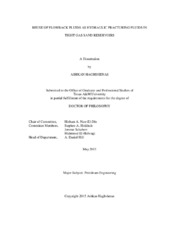| dc.description.abstract | Hydraulic fracturing fluids are usually prepared in the field using fresh water. High costs of water acquisition and waste water disposal, and the lack of available water resources near operation sites, make the reuse of produced water an unavoidable option. One of the fluid properties to be considered in investigating the applicability of these fluids as the fracturing base fluid is the total dissolved solids (TDS).
The main objectives of the first section of this work are to investigate the feasibility of using produced water in hydraulic fracturing in sandstone fields at reservoir temperatures and study the use of chelating agents to expand the acceptable range of TDS in fracturing base fluids. The effect of salts and chelating agents on the proppant transport and rheological properties of fracturing fluids was examined in detail. A high-pH guar/borate fluid was selected as the base fluid and loaded with different concentrations of sodium, potassium, calcium, magnesium, and ethylenediaminetetraacetic acid, diammonium salt (EDTA). The experiments were conducted at 140, 225, and 305°F and a pressure of 300 psi.
The results show that the presence of 2 wt% EDTA increased the acceptable maximum limit for TDS content of the base hydraulic fracturing fluid without compromising the performance of the fluid. More than 85% of analyzed flowback fluids from the West Texas region (Ozona, Canyon) were suitable to be used in future jobs with no further treatment regarding ion contents.
In the second section, we developed a decision tree to optimize selection of fracturing fluid based on extensive reservoir data obtained from tight sand fields in Texas. We reviewed completion and production reports on 164 wells, from five tight gas sand reservoirs in Texas, that were completed using six different fracturing fluid categories. Bottomhole temperature, reservoir pressure gradient, mechanical strength of barriers above and below the target zone, and pay zone thickness were the six selected variables for this analysis. We could reach the Out-Of-Bag error of 28.54% which seems reasonable with the complex dataset understudy. Bottomhole temperature and Young’s modulus of the lower barrier are the most and the least important variables in this process, respectively. CO2/N2/foam assisted hybrid fluid was the best predicted by our model with an error of approximately 20%.
The main objectives of this paper are to: (a) to investigate the feasibility of using produced water in hydraulic fracturing in sandstone fields at reservoir temperatures, (b) introduce new techniques to evaluate the flowback fluid and to purify/qualify produced water at high temperatures, and (c) study the use of chelating agents to expand the acceptable range of TDS in fracturing base fluids. The effect of salts and chelating agents on the proppant transport and rheological properties of fracturing fluids was examined in detail. A high-pH guar/borate fluid was selected as the base fluid and loaded with different concentrations of sodium, potassium, calcium, magnesium, and ethylenediaminetetraacetic acid, diammonium salt (EDTA). The results help to determine which salts can affect the desirable expectation from the fracturing fluid and how to increase the limits further to be able to use the flowback fluids in future hydraulic fracturing jobs. The thermal stability and viscosity measurements were conducted at 140, 225, and 305°F and a pressure of 300 psi. The static settling tests were run at ambient temperature and 225°F.
The results show that the presence of 2 wt% EDTA increased the acceptable maximum limit for TDS content of the base hydraulic fracturing fluid without compromising the performance of the fluid. More than 85% of analyzed flowback fluids from the West Texas region (Ozona, Canyon) were suitable to be used in future jobs with no further treatment regarding ion contents.
We developed a decision method to optimize selection of fracturing fluid based on extensive reservoir data obtained from tight sand fields in Texas. The influential reservoir parameters for development of this model were selected based on information obtained from literature, reservoir simulations, and outcome of surveys filled out by fracturing experts. Correlating these variables and the fracturing fluid is a challenging task.
We reviewed completion and production reports on 164 wells, from Olmos, Bossier, Morrow, Cotton Valley, and Canyon Sand reservoirs, in Texas, that were completed using six different fracturing fluid categories. Six reservoir parameters were selected for this analysis, including bottom-hole temperature, reservoir pressure gradient, formation permeability and Young’s modulus, mechanical strength of barriers above and below the target zone, and pay zone thickness. For this dataset with the mentioned covariates and 164 observations, we could reach the out of sample error rate of 28.54% which seems reasonable with the complex dataset understudy. Bottom-hole temperature, pay zone thickness, and mechanical strength of lower barrier were found to be the most influential parameters for fluid selection which complies with our expectation. Pressure gradient and mechanical strength of the upper barrier were only marginally important in this fracturing fluid selection. CO2, N2, and foam assisted crosslinked gel fluids were best predicted by our model with an error of approximately 20%. | en |


